
Prostanthera incisa, commonly known as cut-leaf mint-bush or native thyme, is a species of flowering plant in the family Lamiaceae and is endemic to south-eastern continental Australia. It is an erect, strongly aromatic, openly branched shrub with hairy, densely glandular branches, egg-shaped to oblong leaves, and pale mauve to mauve flowers.

Prostanthera ovalifolia, commonly known as the oval-leaf mintbush or purple mintbush, is a species of flowering plant in the family Lamiaceae and is endemic to south-eastern continental Australia. It is an erect shrub with egg-shaped leaves and groups of mauve to deep blue-purple flowers arranged in groups at the ends of branchlets.

Prostanthera galbraithiae, commonly known as Wellington mint-bush, is a species of flowering plant in the family Lamiaceae and is endemic to Victoria in Australia. It is an erect or spreading shrub with densely hairy branches that are more or less square in cross-section, narrow egg-shaped or oblong leaves with the edges rolled under, and deep mauve to purple flowers with maroon dots inside the petal tube.

Prostanthera stenophylla is a species of flowering plant in the family Lamiaceae and is endemic to Wollemi National Park in New South Wales. It is an erect, slender, aromatic shrub with hairy, oblong leaves and small groups of pale bluish mauve to violet flowers.
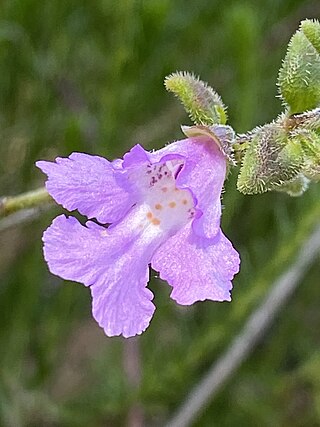
Prostanthera marifolia, commonly known as Seaforth mintbush, is a species of flowering plant that is endemic to a restricted area of New South Wales. It is a small, erect, openly branched shrub with egg-shaped to elliptic leaves, and purple to mauve flowers arranged in leaf axils.
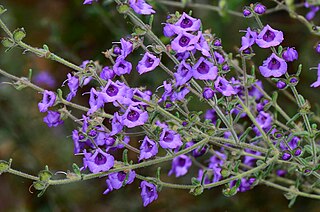
Prostanthera hirtula, commonly known as hairy mintbush, is a species of flowering plant in the family Lamiaceae and is endemic to the south-eastern continental Australia. It is a strongly aromatic, densely hairy, spreading shrub with narrow egg-shaped leaves and dark mauve flowers, and that grows in exposed, rocky sites.

Prostanthera saxicola is a species of flowering plant in the family Lamiaceae and is endemic to eastern Australia. It is a shrub with linear to elliptic leaves and white to mauve flowers arranged in leaf axils.
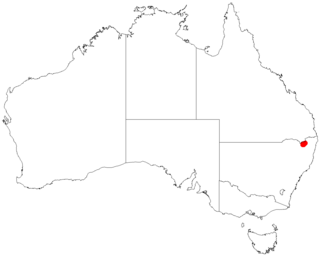
Prostanthera staurophylla, commonly known as Tenterfield mint-bush, is a species of flowering plant in the family Lamiaceae and is endemic to a small area on the New England Tableland of New South Wales. It is an erect to spreading, strongly aromatic shrub with hairy branches, deeply lobed leaves and bluish-mauve flowers with darker markings.
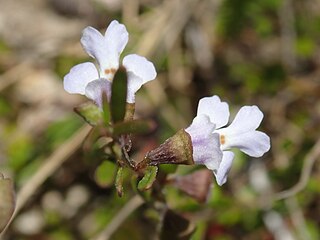
Prostanthera junonis, commonly known as Somersby mintbush, is a species of flowering plant in the family Lamiaceae and is endemic to the Central Coast of New South Wales. It is a low, straggling shrub with hairy, egg-shaped leaves and purple to mauve flowers.

Prostanthera askania, commonly known as tranquility mintbush, is a shrub that is endemic to Australia. It has mostly pale mauve flowers, strongly scented leaves and branches, dull green, toothed egg-shaped leaves and a restricted distribution.

Prostanthera cineolifera, commonly known as the Singleton mint bush, is a species of flowering plant in the family Lamiaceae and is endemic to eastern New South Wales. It is an erect shrub with hairy branches, narrow egg-shaped leaves and clusters of pale mauve to dark purple-mauve flowers arranged on the ends of branchlets.
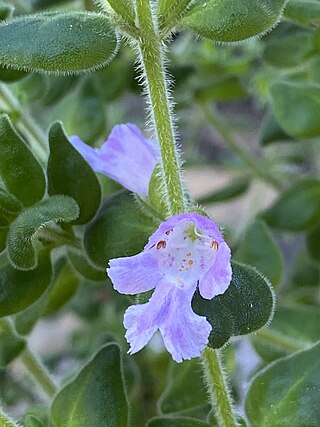
Prostanthera densa, commonly known as villous mint-bush, is a species of flowering plant in the family Lamiaceae and is endemic to near-coastal areas of New South Wales. It is an erect, often compact shrub with aromatic branches, egg-shaped leaves, and mauve flowers with orange markings inside.
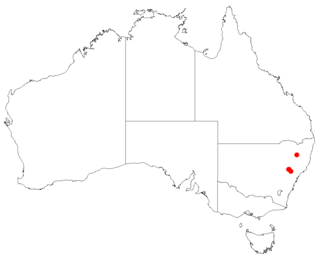
Prostanthera discolor is a species of flowering plant in the family Lamiaceae and is endemic to a small area of New South Wales. It is an open, erect, strongly aromatic shrub with lance-shaped to oblong leaves, and deep mauve to purple flowers with darker spots inside.
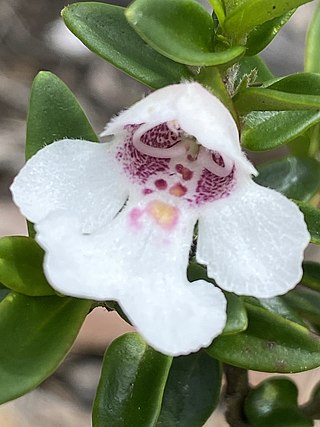
Prostanthera gilesii is a species of flowering plant in the family Lamiaceae and is endemic to the Mount Canobolas area of New South Wales. It is a small, compact, spreading shrub with aromatic, narrow egg-shaped to elliptical leaves, and white to yellowish white flowers with purple to dark mauve markings inside the petal tube and pale orange markings on the petal lobes.

Prostanthera granitica, commonly known as the granite mintbush, is a species of flowering plant in the family Lamiaceae and is endemic to eastern Australia. It is a spreading shrub with egg-shaped leaves with the edges rolled under, and purple to violet flowers.
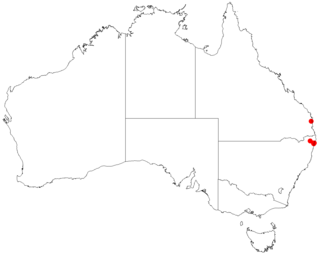
Prostanthera palustris, commonly known as swamp mint-bush, is a species of flowering plant in the family Lamiaceae and is endemic to a restricted area of New South Wales. It is a low, spreading, weak shrub with spatula-shaped leaves and pale mauve and white flowers with yellow spots in the petal tube.
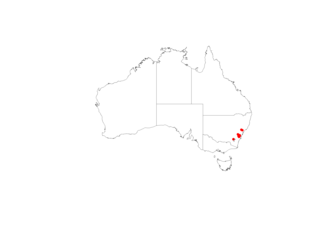
Prostanthera rugosa is a species of flowering plant in the family Lamiaceae and is endemic to a restricted area of New South Wales. It is an openly-branched shrub with egg-shaped or narrow egg-shaped, thick, fleshy leaves and mauve flowers with a white tinge arranged in leaf axils near the ends of branchlets.
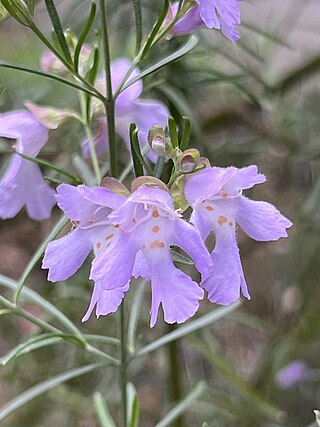
Prostanthera sericea, commonly known as silky mintbush or walyuwalyu, is a species of flowering plant in the family Lamiaceae and is endemic to inland Australia. It is an erect shrub with hairy branches, cylindrical leaves and white flowers with mauve or purple streaks.

Prostanthera tozerana is a species of flowering plant that is endemic to Mount Tozer in Queensland. It is a small, compact shrub with hairy branchlets, thick egg-shaped leaves with the narrower end towards the base, and pale purplish-mauve flowers.

Prostanthera violacea, commonly known as violet mint-bush, is a species of flowering plant in the family Lamiaceae and is endemic to south-eastern New South Wales. It is a slender, strongly aromatic shrub with densely hairy branches, more or less round leaves with the edges rolled under and mauve to bluish flowers often with white tips.






















